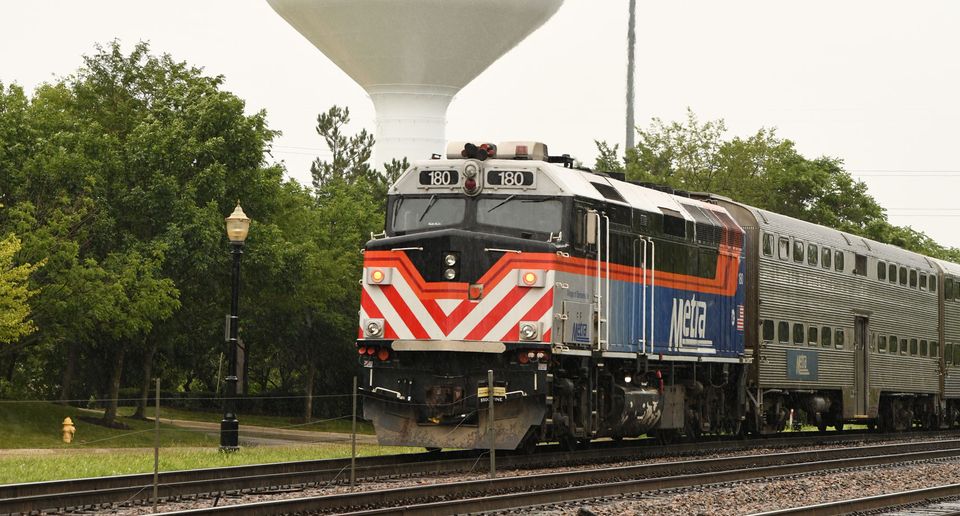Metra, the commuter rail system that serves Chicago and its suburbs, could face fresh challenges when federal operating funds run out in 2025.
A transit expert said it could require government intervention to keep agencies like Metra afloat.
Like other public transit agencies across the country, Metra has been using federal COVID-19 relief funds to balance its budgets since the pandemic. Metra plans to use $705 million in federal money to balance its budget through 2024.
That influx of federal money is expected to run out by 2025. It remains uncertain if ridership will return to pre-pandemic levels for the commuter train service with a network of 11 lines on 1,200 miles of track in Cook County and the collar counties of DuPage, Kane, Lake, McHenry and Will along with Kenosha, Wisconsin.
P.S. Sriraj, director of the Urban Transportation Center at the University of Illinois Chicago, said that public transportation ridership started falling nationally on a year-to-year basis in 2014 as a result of multiple factors, including the emergence of ride-hailing apps and changing office policies. Then came COVID-19.
“There was a very perceptible, very slight drop in ridership every year and the pandemic took the bottom out of that and made the ridership fall to precipitous lows,” he said. “Even without the pandemic, ridership would have slowly eroded, but the pandemic accelerated that erosion.”
Sriraj said that because of that base erosion, ridership may never return to pre-pandemic levels.
“I don’t think that ridership will ever go back to what it was,” he said. “But to what levels it will drop is the more important question.”
Ridership has yet to rebound for many public transit agencies.
Ridership declined by 24.3%, or 4.5 million rides, in 2021 compared to 2020, according to the agency’s audited financial statements. Metra provided 14.1 million rides in 2021 compared to 18.6 million rides in 2020. In 2019, Metra provided 74 million rides. As ridership fell for the second year in a row amid the ongoing COVID-19 pandemic, so did passenger revenue. Passenger revenue declined $35 million, or 34.2%, to $67.4 million in 2021.
“The evidence, at least as of now, is that even though Metra and other agencies have tried to incentivize riders with more cost-friendly fare pricing and fare mechanisms, the ridership rebound has not yet happened,” Sriraj said.
The pandemic “ripped the Band-Aid off” public transit, he said. It forced transit agencies to face a new reality.
“They had to wake up to the reality of the fact that public transportation as we knew it, as we know it, as we will ever remember it, may not be the same again,” Sriraj said. “The base ridership has changed because employer-employee relationships are evolving, because technology reinforced the confidence on the part of the employer and the employee that the commute to work may not be as important as it was deemed to be once upon a time.”
While ridership remains significantly below 2019 levels, Metra’s expenses have continued to climb. Total operating expenses before depreciation increased 6.7% in 2021 to $730.5 million, including a 30% increase in administration expenses and a 38.7% increase in engineering expenses, according to the agency’s audited financial statements.
The base ridership going forward won’t necessarily be the same as it was pre-pandemic. Sriraj said it might be similar to the ridership during the pandemic: manufacturing, health care and service sector workers along with other front-line employees.
“Metra’s bread and butter has been the peak service,” Sriraj said. “They don’t have the mandate, they don’t have the expectation to offer services during the mid-day hours as Chicago Transit Authority does. So, in a way, if it comes down to dollars and cents – and this will affect people in some industries, I’m not denying that at all – they’ll have to be cuts made in the Metra workforce, but that may be the reality that they have to eliminate some of the off-peak, mid-day services and focus their efforts on running a leaner peak schedule. That will be the best-case scenario for them.”
Metra Director of Communications Michael Gillis said it is too early to speculate if the agency will need to raise fares or consider service cuts. For now, with federal emergency operating money in hand, the agency is focused on ridership.
“Like our sister agencies in the Chicago area and like mass transit agencies across the country, right now we are working to rebuild ridership,” he said.
Fewer passengers since the pandemic have put a damper on Metra’s farebox recovery ratio, or the amount of money passengers pay to offset the overall cost of operating the system. In November 2021, the year-to-date farebox recovery ratio was 38%, below the agency’s 52.5% target. Before the pandemic shutdowns, in December 2019, the year-to-date farebox recovery ratio was 55.4%. Gillis said Metra has been supplementing its farebox revenue with federal COVID-19 relief money. The recovery ratio after federal relief was 52.6%, he said.
Ridership recovery is expected to take time.
“Our 2022 budget projected ridership would start the year at 25% of our pre-COVID numbers and finish at 35%,” Gillis said. “We did not start at 25% but we are now at about 35-40%. For 2023, we projected we’d finish at 65% of our 2019 numbers and for 2024 we predicted we’d finish at 80%.”
Gillis said those figures could be updated in the fall.
This article originally appeared on The Center Square.






